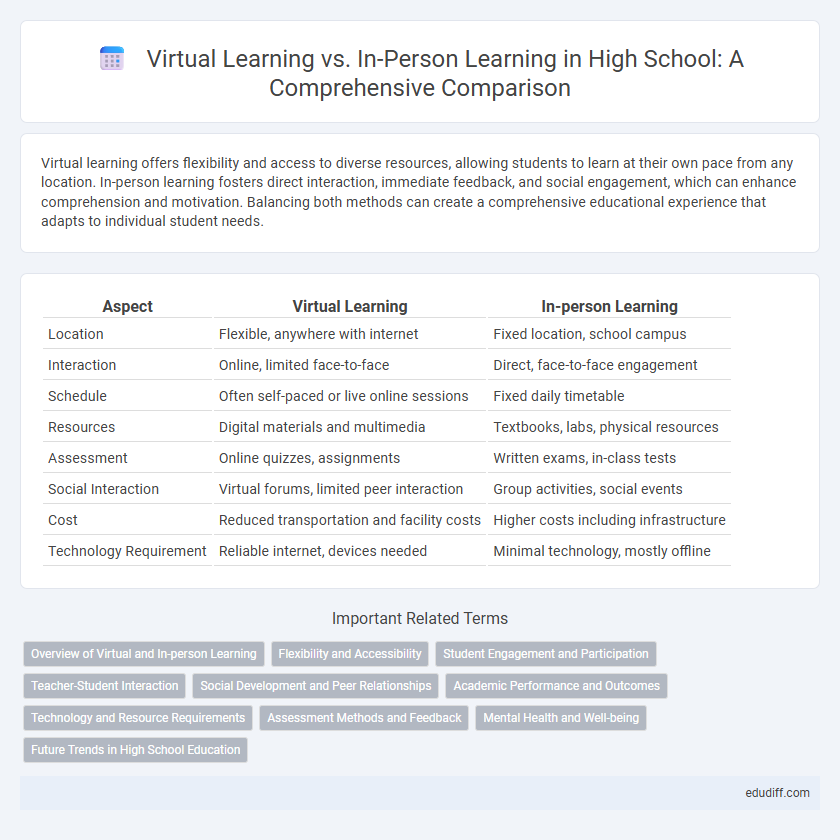Virtual learning offers flexibility and access to diverse resources, allowing students to learn at their own pace from any location. In-person learning fosters direct interaction, immediate feedback, and social engagement, which can enhance comprehension and motivation. Balancing both methods can create a comprehensive educational experience that adapts to individual student needs.
Table of Comparison
| Aspect | Virtual Learning | In-person Learning |
|---|---|---|
| Location | Flexible, anywhere with internet | Fixed location, school campus |
| Interaction | Online, limited face-to-face | Direct, face-to-face engagement |
| Schedule | Often self-paced or live online sessions | Fixed daily timetable |
| Resources | Digital materials and multimedia | Textbooks, labs, physical resources |
| Assessment | Online quizzes, assignments | Written exams, in-class tests |
| Social Interaction | Virtual forums, limited peer interaction | Group activities, social events |
| Cost | Reduced transportation and facility costs | Higher costs including infrastructure |
| Technology Requirement | Reliable internet, devices needed | Minimal technology, mostly offline |
Overview of Virtual and In-person Learning
Virtual learning leverages digital platforms to deliver high school curricula through interactive video lessons, online assignments, and real-time communication tools, promoting flexibility and access to diverse resources. In-person learning centers on direct student-teacher interaction within a physical classroom, fostering immediate feedback, hands-on activities, and social engagement crucial for collaborative skills development. Both methods impact academic performance and student motivation differently, with technology integration playing a pivotal role in virtual settings and face-to-face mentorship dominating traditional classrooms.
Flexibility and Accessibility
Virtual learning enhances flexibility by allowing students to access coursework anytime and anywhere, accommodating diverse schedules and learning paces. In-person learning offers structured routines and immediate access to teachers and peers, fostering engagement through direct interaction. Accessibility in virtual education bridges geographical barriers and supports students with mobility challenges, while traditional classrooms provide essential social experiences and hands-on activities.
Student Engagement and Participation
Virtual learning offers flexible access to educational resources, but often faces challenges in maintaining consistent student engagement due to screen fatigue and limited social interaction. In-person learning facilitates active participation through face-to-face discussions, collaborative group activities, and immediate feedback from teachers, enhancing overall student involvement. Data from studies show that students in traditional classrooms exhibit higher levels of attentiveness and contribution compared to their virtual counterparts.
Teacher-Student Interaction
Teacher-student interaction in virtual learning environments often relies on digital communication tools, which can limit spontaneous feedback and non-verbal cues essential for effective teaching. In-person learning fosters immediate, dynamic engagement through face-to-face conversations, body language, and real-time clarification, enhancing comprehension and student motivation. Research indicates that active, personal interaction in classrooms contributes to improved academic performance and emotional support compared to the more structured, less interactive virtual settings.
Social Development and Peer Relationships
Virtual learning often limits face-to-face interactions, reducing opportunities for developing essential social skills and peer relationships that thrive in a physical classroom setting. In-person learning fosters spontaneous communication, group activities, and collaborative problem-solving, which are critical for building empathy, teamwork, and social competence among high school students. Research indicates students engaged in traditional classrooms exhibit stronger social bonds and emotional support networks compared to those in fully remote environments.
Academic Performance and Outcomes
Virtual learning offers flexible schedules and personalized pacing, which can enhance academic performance for self-motivated high school students. In-person learning provides structured environments and immediate teacher feedback, leading to higher engagement and better outcomes for students who benefit from direct interaction. Studies indicate that a blended approach often balances the strengths of both, optimizing overall academic success.
Technology and Resource Requirements
Virtual learning in high schools demands reliable internet access, updated devices like laptops or tablets, and robust learning management systems to facilitate online coursework and communication. In-person learning requires physical resources including classrooms equipped with projectors, whiteboards, and printed materials, as well as technology for interactive lessons such as smartboards and computer labs. The disparity in technology and resource availability directly impacts student engagement, instructional quality, and academic performance in both learning environments.
Assessment Methods and Feedback
Virtual learning relies heavily on digital assessment tools such as online quizzes, automated grading systems, and interactive assignments to provide immediate feedback, enhancing timely student improvement. In-person learning offers more personalized and nuanced assessment through direct teacher observation, oral presentations, and handwritten exams, allowing for real-time clarification and detailed feedback sessions. Hybrid approaches combine digital analytics with face-to-face interaction, optimizing assessment accuracy and feedback effectiveness in high school education.
Mental Health and Well-being
Virtual learning offers flexibility and reduces social anxiety, benefiting students who struggle with traditional classroom settings, but it can also contribute to feelings of isolation and decreased motivation in high school students. In-person learning promotes social interaction and emotional support from peers and teachers, which are crucial for adolescent mental health and well-being, yet it may increase stress due to social pressures and rigid schedules. Balancing both methods with mental health resources is essential to optimize overall well-being and academic success in the high school environment.
Future Trends in High School Education
Virtual learning in high schools is rapidly evolving with advancements in AI-driven personalized education and immersive VR classrooms, enhancing student engagement and accessibility. In-person learning continues to emphasize social interaction and hands-on experiences, but hybrid models are becoming increasingly prevalent to combine flexibility and collaboration. Future trends suggest a blended approach leveraging technology to tailor learning paths while maintaining essential face-to-face communication skills.
Virtual Learning vs In-person Learning Infographic

 edudiff.com
edudiff.com